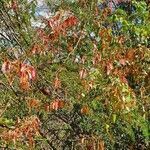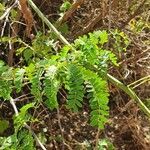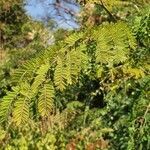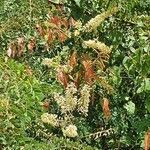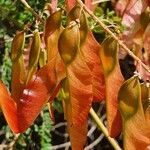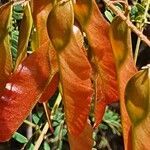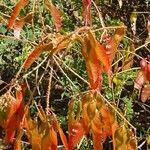Scrambling or climbing, rarely semi-erect shrub 2–15 m. high.. Stems ± puberulous, at least when young, armed with reflexed prickles paired at nodes and often also with scattered ones between the nodes.. Leaves: petiole with rhachis 6–16(–25) cm. long, the latter armed with mostly paired reflexed prickles, straight ascending ones also being often present on the upper side of the rhachis at the insertions of pinnae; pinnae 5–13 pairs; leaflets 7–15(–16, fide F.C.B.) pairs, narrowly oblong or elliptic-oblong, with the terminal ones ± obovate, 4–12 mm. long, 2–4.5(–5) mm. wide, rounded to emarginate at apex, ± puberulous or pubescent to almost glabrous.. Racemes 5–13(–18) cm. long, puberulous or shortly pubescent, aggregated into panicles up to ± 35 cm. long and 22 cm. wide.. Pedicels 3–5(–6) mm. long.. Flowers sweetly scented, pale creamy-yellow except for the pale green calyx.. Sepals ± 2–3 mm. long.. Petals oblanceolate-oblong, ± 3 mm. long and 1.5 mm. wide, pubescent towards base.. Stamen-filaments 4–5 mm. long.. Ovary pubescent.. Pods brick-red to scarlet, ultimately brown, 3–6 cm. long, thinly pubescent or puberulous to glabrous; wing 2.3–4.5 cm. long, 0.9–1.6 cm. wide at widest point.. Seeds ovoid-ellipsoid, ± 11 mm. long, 6.5 mm. wide, olive.. Fig. 7, p. 41.
Leaves: petiole and rachis together 5–17(25) cm long, armed on the lower side with downwardly hooked prickles in pairs at the insertions of the pinnae and occasionally singly between the pinnae, and on the upper side usually also with straight, erect or forwardly pointed prickles singly at the insertions of the pinnae; pinnae (5)7–13 pairs; pinna rachis (1.5)2.5–5(6) cm; leaflets 7–16 pairs per pinna, (4)6–10(12) × 2–3.5(5 in F.T.E.A.), oblong, rounded to slightly emarginate at the apex; lower surface pubescent, upper surface glabrous or sometimes pubescent.
A scrambling shrub. It can grow 15 m high. The young stems are covered hairs and with prickles. The leaves are compound. The leaflets are 6-10 mm long and 2-4 mm wide with 7-16 pairs of leaflets per leaflet stalk. The fruit is a pod with wings. It is bright red. The pods are 3-5 cm long. The seed is at the base and is 10 mm long by 5-7 mm wide and 3 mm thick.
Stems densely puberulous when young, and armed with downwardly hooked prickles up to 6 mm long in pairs at the insertions of the leaves and occasionally singly elsewhere, the prickles on older stems becoming raised on corky bosses as in Mezoneuron angolense (in photograph of Wild s.n. from Zimbabwe in SRGH).
Pods (including the wing) 3–5(6) cm long, the wing up to 1.7 cm broad, the seed-containing basal part up to 2 × 1 cm, pubescent or at maturity glabrescent, a striking scarlet or wine-red while maturing, ultimately brown; seed 9–11 × 5–6.5 × 3.4 mm, ellipsoid.
Scrambling or climbing shrub, up to 15 m high, armed with prickles. Racemes 50-180 mm long, terminal and axillary, aggregated into panicles up to 350 mm long, puberulous to shortly pubescent. Pods samaroid. Flowers pale yellowish white.
Flowers sweetly scented, small, in dense terminal and lateral racemes up to 18 cm long, aggregated into pseudopanicles up to 35 cm long; bracts subulate, falling very early; pedicels 3–5(6) mm.
Stamens all exserted, the longer ones almost twice as long as the petals; anthers c.0.5 mm long.
Petals about equalling the sepals, erect, oblanceolate-oblong, glabrous, cream coloured.
Sepals 2–3 × 0.75–1.4 mm, usually ± reflexed in flower, pubescent, greenish.
A scrambling or climbing shrub up to 20 m high.
Ovary densely pubescent.
